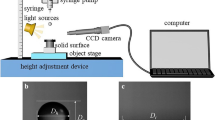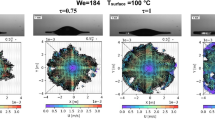Abstract
In this work, the impact dynamics of high-viscous nanofluid droplets onto a solid surface has been investigated experimentally by means of high-speed camera visualization technique. We dispersed various nanoparticles (multiwall carbon nanotube (MWCNT), nano-graphene, and nano-graphite powder) into high-viscous base fluid (epoxy resin) to obtain the stable and homogenous nanofluids without surfactant additives. The well dispersed nanofluids show different degree of shear-thinning behaviors, and the shear-thinning properties of those fluids have been characterized by the power-law rheology model. The dynamic contact angle (DCA), transient dimensionless height, and transient contacting factor along with the spreading time under different Weber numbers (We) have been investigated. The results show that the nanofluid with a lower shear viscosity over the entire range of the shear rates results in larger variations of the contacting factor and the dimensionless height. The effect of surface wettability on droplet impact behaviors is more significant for the fluid with higher shear viscosity and less shear-thinning degree during the receding phase. The latter spreading and receding motions of the droplet with higher shear viscosity and shear-thinning degree are suppressed significantly, regardless of the Weber numbers in current study. Finally, a model based on experimental data has been proposed to predict the maximum spreading factor of high-viscous droplet impact on solid surface.
Similar content being viewed by others
References
An, S.M. and S.Y. Lee, 2012, Observation of the spreading and receding behavior of a shear-thinning liquid drop impacting on dry solid surfaces, Exp. Therm. Fluid Sci. 37, 37–45.
Andrade, R., O. Skurtys, and F. Osorio, 2015, Development of a new method to predict the maximum spread factor for shear thinning drops, J. Food Eng. 157, 70–76.
Attané, P., F. Girard, and V. Morin, 2007, An energy balance approach of the dynamics of drop impact on a solid surface, Phys. Fluids 19, 012101.
Bartolo, D., A. Boudaoud, G. Narcy, and D. Bonn, 2007, Dynamics of non-Newtonian droplets, Phys. Rev. Lett. 99, 174502.
Bergeron, V., D. Bonn, J.Y. Martin, and L. Vovelle, 2000, Controlling droplet deposition with polymer additives, Nature 405, 772–775.
Bertola, V., 2015, An impact regime map for water drops impacting on heated surfaces, Int. J. Heat Mass Transf. 85, 430–437.
Boyer, F., E. Sandoval-Nava, J.H. Snoeijer, J.F. Dijksman, and D. Lohse, 2016, Drop impact of shear thickening liquids, Phys. Rev. Fluids 1, 013901.
Breitenbach, J., J. Kissing, I.V. Roisman, and C. Tropea, 2018, Characterization of secondary droplets during thermal atomization regime, Exp. Therm. Fluid Sci. 98, 516–522.
Choi, S.U.S., 1995, Enhancing thermal conductivity of fluids with nano-particles, ASME, FED 231, 99–105.
Clanet, C., C. Béguin, D. Richard, and D. Quéré, 2004, Maximal deformation of an impacting drop, J. Fluid Mech. 517, 199–208.
Derby, B., 2012, Printing and prototyping of tissues and scaffolds, Science 338, 921–926.
Duan, F., T. Wong, and A. Crivoi, 2012, Dynamic viscosity measurement in non-Newtonian graphite nanofluids, Nanoscale Res. Lett. 7, 360.
Eggers, J., M.A. Fontelos, C. Josserand, and S. Zaleski, 2010, Drop dynamics after impact on a solid wall: Theory and simulations, Phys. Fluids 22, 062101.
Finotello, G., S. De, J.C.R. Vrouwenvelder, J.T. Padding, K.A. Buist, A. Jongsma, F. Innings, and J.A.M. Kuipers, 2018, Experimental investigation of non-Newtonian droplet collisions: The role of extensional viscosity, Exp. Fluids 59, 113.
German, G. and V. Bertola, 2009, Impact of shear-thinning and yield-stress drops on solid substrates, J. Phys.-Condens. Matter 21, 375111.
Hadadian, M., E.K. Goharshadi, and A. Youssefi, 2014, Electrical conductivity, thermal conductivity, and rheological properties of graphene oxide-based nanofluids, J. Nanopart. Res. 16, 2788.
Hao, C., Y. Zhou, X. Zhou, L. Che, B. Chu, and Z. Wang, 2016, Dynamic control of droplet jumping by tailoring nanoparticle concentrations, Appl. Phys. Lett. 109, 021601.
Jiang, L., L. Gao, J. Sun, 2003, Production of aqueous colloidal dispersions of carbon nanotubes, J. Colloid Interface Sci. 260, 89–94.
Jiao, Z., F. Li, L. Xie, X. Liu, B. Chi, and W. Yang, 2018, Experimental research of drop-on-demand droplet jetting 3D printing with molten polymer, J. Appl. Polym. Sci. 135, 45933.
Josserand, C. and S.T. Thoroddsen, 2016, Drop impact on a solid surface, Annu. Rev. Fluid Mech. 48, 365–391.
Kole, M. and T.K. Dey, 2013, Investigation of thermal conductivity, viscosity, and electrical conductivity of graphene based nanofluids, J. Applied Phys. 113, 084307.
Li, Y., F. Wang, H. Liu, and H. Wu, 2015, Nanoparticle-tuned spreading behavior of nanofluid droplets on the solid substrate, Microfluid. Nanofluid. 18, 111–120.
Liu, H.L., J.S. Moon, and W.R. Hwang, 2012, Numerical simulation of a shear-thinning fluid through packed spheres, Korea-Aust. Rheol. J. 24, 297–306.
Ma, A.W.K., F. Chinesta, and M.R. Mackley, 2009, The rheology and modeling of chemically treated carbon nanotubes suspensions, J. Rheol. 53, 547–573.
Macosko, C.W., 1994, Rheology: Principles, Measurements, and Applications, 1st ed., Wiley-VCH, New York.
Mandani, S., M. Norouzi, and M.M. Shahmardan, 2018, An experimental investigation on impact process of Boger drops onto solid surfaces, Korea-Aust. Rheol. J. 30, 99–108.
Masiri, S.M., M. Bayareh, and A.A. Nadooshan, 2019, Pairwise interaction of drops in shear-thinning inelastic fluids, Korea-Aust. Rheol. J. 31, 25–34.
Mehrali, M., E. Sadeghinezhad, M.M. Rashidi, A.R. Akhiani, S.T. Latibari, M. Mehrali, and H.S.C. Metselaar, 2015, Experimental and numerical investigation of the effective electrical conductivity of nitrogen-doped graphene nanofluids, J. Nanopart. Res. 17, 1–17.
Moghaddam, M.B., E.K. Goharshadi, M.H. Entezari, and P. Nancarrow, 2013, Preparation, characterization, and rheological properties of graphene-glycerol nanofluids, Chem. Eng. J. 231, 365–372.
Moon, J.H., J.B. Lee, and S.H. Lee, 2013, Dynamic behavior of non-Newtonian droplets impinging on solid surfaces, Mater. Trans. 54, M2012215.
Mourougou-Candoni, N., B. Prunet-Foch, F. Legay, M. Vignes-Adler, and K. Wong, 1999, Retraction phenomena of surfactant solution drops upon impact on a solid substrate of low surface energy, Langmuir 15, 6563–6574.
Murshed, S.M.S. and P. Estellé, 2017, A state of the art review on viscosity of nanofluids, Renew. Sust. Energ. Rev. 76, 1134–1152.
Özerinç, S., S. Kakaç, and A.G. Yazıcıoğlu, 2010, Enhanced thermal conductivity of nanofluids: A state-of-the-art review, Microfluid. Nanofluid. 8, 145–170.
Park, C., Z. Ounaies, K.A. Watson, R.E. Crooks, J. Smith, S.E. Lowther, J.W. Connell, E.J. Siochi, J.S. Harrison, and T.L.S. Clair, 2002, Dispersion of single wall carbon nanotubes by in situ polymerization under sonication, Chem. Phys. Lett. 364, 303–308.
Richter, B., K. Dullenkopf, and H.-J. Bauer, 2005, Investigation of secondary droplet characteristics produced by an isooctane drop chain impact onto a heated piston surface, Exp. Fluids 39, 351–363.
Rioboo, R., M. Marengo, and C. Tropea, 2002, Time evolution of liquid drop impact onto solid, dry surfaces, Exp. Fluids 33, 112–124.
Roisman, I.V., E. Berberović, and C. Tropea, 2009, Inertia dominated drop collisions. I. On the universal flow in the lamella, Phys. Fluids 21, 052103.
Rozhkov, A., B. Prunet-Foch, and M. Vignes-Adler, 2010, Impact of drops of surfactant solutions on small targets, Proc. R. Soc. A-Math. Phys. Eng. Sci. 466, 2897–2916.
Scheller, B.L. and D.W. Bousfield, 1995, Newtonian drop impact with a solid surface, AIChE J. 41, 1357–1367.
Srikar, R., T. Gambaryan-Roisman, C. Steffes, P. Stephan, C. Tropea, and A.L. Yarin, 2009, Nanofiber coating of surfaces for intensification of drop or spray impact cooling, Int. J. Heat Mass Transf. 52, 5814–5826.
Stalder, A.F., G. Kulik, D. Sage, L. Barbieri, and P. Hoffmann, 2006, A snake-based approach to accurate determination of both contact points and contact angles, Colloid Surf. A-Physicochem. Eng. Asp. 286, 92–103.
Vega, E.J. and A.A. Castrejón-Pita, 2017, Suppressing prompt splash with polymer additives, Exp. Fluids 58, 57.
Wasan, D.T. and A.D. Nikolov, 2003, Spreading of nanofluids on solids, Nature 423, 156–159.
Yarin, A.L., 2006, Drop impact dynamics: Splashing, spreading, receding, bouncing …, Annu. Rev. Fluid Mech. 38, 159–192.
Yearsley, K.M., M.R. Mackley, F. Chinesta, and A. Leygue, 2012, The rheology of multiwalled carbon nanotube and carbon black suspensions, J. Rheol. 56, 1465–1490.
Yoo, H. and C. Kim, 2015, Generation of inkjet droplet of suspension in polymer solution, Korea-Aust. Rheol. J. 27, 137–149.
Zang, D., X. Wang, X. Geng, Y. Zhang, and Y. Chen, 2013, Impact dynamics of droplets with silicananoparticles and polymer additives, Soft Matter 9, 394–400.
Zhang, L., T. Ku, X. Cheng, Y. Song, and D. Zhang, 2018, Inkjet droplet deposition dynamics into square microcavities for OLEDs manufacturing, Microfluid. Nanofluid. 22, 47.
Acknowledgments
This work was supported by National Natural Science Foundation of China (No. 51506078, No. 51876086, and No. 51706089) and the Doctoral Fund of Ministry of Education of China (2015M581732).
Author information
Authors and Affiliations
Corresponding author
Additional information
Publisher’s Note
Springer Nature remains neutral with regard to jurisdictional claims in published maps and institutional affiliations.
Rights and permissions
About this article
Cite this article
Liu, H.L., Shen, X., Wang, R. et al. Spreading behaviors of high-viscous nanofluid droplets impact on solid surfaces. Korea-Aust. Rheol. J. 31, 167–177 (2019). https://doi.org/10.1007/s13367-019-0017-2
Received:
Revised:
Accepted:
Published:
Issue Date:
DOI: https://doi.org/10.1007/s13367-019-0017-2




